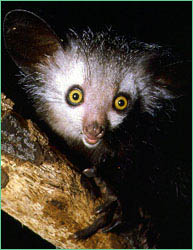This family contains a single species, the highly distinctive aye-aye. These animals are around 400 mm long excluding the bushy tail, which more than doubles the body length. The fur is long, woolly, and dark brown in color. The combination of bushy tail and woolly fur gives the animal a sort of unkempt, shaggy appearance. Aye-ayes have large, naked, mobile ears, a muzzle that is shorter than that of most lemurs but longer than lorises, and large eyes with yellowish brown irises.
Daubentoniidae
aye-aye
The forefeet of aye-ayes are unique. All foretoes are long and thin, but the third is extraordinarily so due to an especially elongated metacarpal. It and all other toes except the hallux bear claws; the hallux has a nail. Aye-ayes also have an unmistakeable skull and teeth. Unlike all other strepsirhines, they lack a toothcomb. The adult dental formula is 1/1, 0/0, 1/0, 3/3 = 18 (the deciduous dentition includes extra upper and lower incisors, premolars, and an upper canine). The adult incisors are tremendously enlarged and evergrowing. Only their anterior surface bears enamel, so they self-sharpen as they wear in the same manner as rodent incisors. Posterior to the incisors is a diastema. The cheekteeth are flattened and have indistinct cusps. The skulls are rounded and the facial region is reduced. An interparietal is present. The postorbital bar is complete, and the foramen magnum is shifted well beneath the skull. The bullae are large and enclose the tympanic ring. The dentary is also distinctively shaped, broad, with a relatively small coronoid process but a large articular process and condyle. The condyle is shifted ventrally relative to the dentary toothrow.
Aye-ayes eat insect larvae, which they retrieve from bark and wood by gnawing holes with their rodent-like incisors, then hooking the larvae out with their enlarged third forefingers. They locate wood-boring larvae by tapping on branches with the third finger and listening for movement. They also feed on fruit, eggs, and bamboo shoots.
These animals are quadrupedal. They do not use the "vertical clinging and leaping" style of locomotion common to many other strepsirhines. Little is known about their social behavior; aye-ayes are usually seen singly or in pairs. They occasionally emit brief cries but are usually silent.
The fossil record of aye-ayes extends to the Pleistocene.
HOME
Primates
Primate FAQ
Primate Species
Aye-aye Pictures
Search primates.com
Primates E-Mail Service
